|
Lysander Mk.III
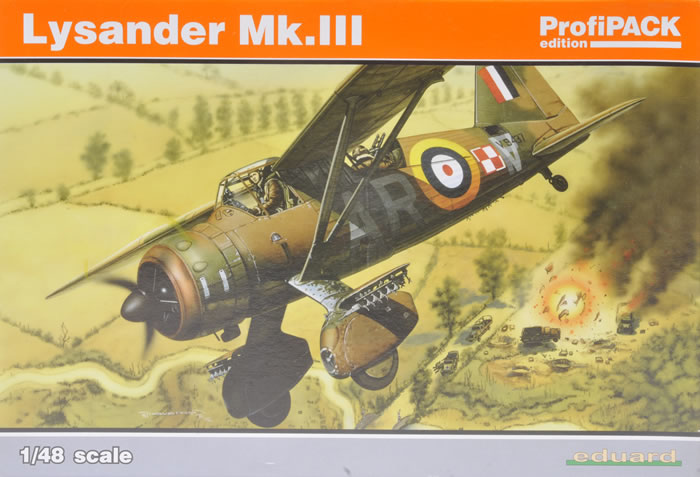
Eduard ProfiPACK, 1/48 scale
S
u m m a r y |
| Catalogue Number: |
Eduard Kit No. 8290 - Lysander Mk.III Weekend Edition |
| Scale: |
1/48 |
| Contents and Media: |
96 parts in grey coloured plastic; seven parts in clear; colour photo-etched fret; self-adhesive masking sheet; markings for five aircraft |
| Price: |
USD$49.95 plus shipping,
available online now from Eduard
USD$39.99 plus shipping available online from Squadron |
| Review Type: |
FirstLook |
| Advantages: |
Crisp surface textures, good quality mouldings; high level of detail including photo-etched parts; simple parts breakdown; five marking options. |
| Disadvantages: |
|
| Conclusion: |
Eduard's 1/48 scale Lysander dates from 2001 and therefore represents a different generation of tooling and detail compared to recent releases. Even so, Eduard's 1/48 scale Lysander is still the best kit of the type and stands up to scrutiny very well today, especially with the inclusion of photo-etched detail parts, plus masks to deal with that pesky glasshouse canopy! Definitely Still Recommended. |
Reviewed by Brett Green

Eduard's 1/48 scale Lysander is available online from Squadron.com
The Westland Lysander was a British army co-operation and liaison aircraft produced by Westland Aircraft used immediately before and during the Second World War.
After becoming obsolete in the army co-operation role, the aircraft's exceptional short-field performance enabled clandestine missions using small, unprepared airstrips behind enemy lines to place or recover agents, particularly in occupied France with the help of the French Resistance.
In August 1941 a new squadron, No. 138 (Special Duties), was formed to undertake missions for the Special Operations Executive to maintain clandestine contact with the French Resistance. Among its aircraft were Lysander Mk IIIs, which flew over and landed in occupied France.
While general supply drops could be left to the rest of No. 138's aircraft, the Lysander could insert and remove agents from the continent or retrieve Allied aircrew who had been shot down over occupied territory and had evaded capture. For this role the Mk IIIs were fitted with a fixed ladder over the port side to hasten access to the rear cockpit and a large drop tank under the belly. In order to slip in unobtrusively Lysanders were painted matte black; operations almost always took place within a week of a full moon, as moonlight was essential for navigation. The aircraft undertook such duties until the liberation of France in 1944.

Lysanders flew from secret airfields at Newmarket and later Tempsford, but used regular RAF stations to fuel-up for the actual crossing, particularly RAF Tangmere.
Flying without any navigation equipment other than a map and compass, Lysanders would land on short strips of land, such as fields, marked out by four or five torches or to avoid having to land, the agent, wearing a special padded suit, stepped off at very low altitude and rolled to a stop on the field.
The Lysander was originally designed to carry one passenger in the rear cockpit, but for SOE use the rear cockpit was modified to carry two passengers in extreme discomfort in case of urgent necessity.
The pilots of No. 138 and from early 1942, No. 161 Squadron transported 101 agents to and recovered 128 agents from Nazi-occupied Europe.
The Germans knew little about the British aircraft and wished to study one. Soldiers captured an intact Lysander in March 1942 when its pilot was unable to destroy it after a crash, but a train hit the truck carrying the Lysander, destroying the cargo.*
Gavia, a brand associated with Eduard, was first released back in 2001. This undoubtedly places it in an earlier generation but it has stood the test of time well.
Eduard's 1/48 scale Lysander Mk.III comprises 96 pieces in medium grey plastic, seven parts in clear, a colour photo-etched fret, a self-adhesive die cut masking sheet plus five marking options in this ProfiPACK Edition.
Despite its vintage, the sprues have held up very well with no hint of flash. This time around the model is moulded in the medium grey plastic that we find in the latest generation of Eduard kits. I know it's just a colour (well, a shade really), but to my eye it makes the sprues look more up to date.
Construction commences with the cockpit, which is built up inside a separate framework representing the tubular structure of the original. The cockpit receives a detail boost from coloured photo-etched parts for the instrument panel., harness straps, radios and more.
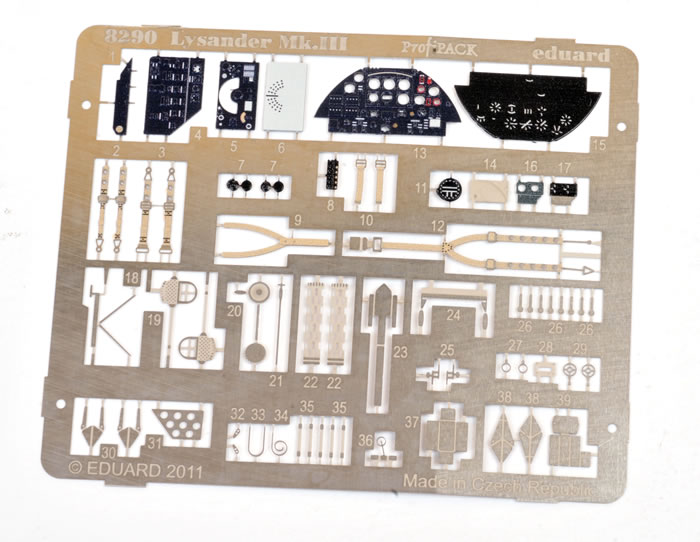
This boxing also includes an optional extra fuel tank inside the cockpit. This is relevant for SOE missions undertaken by 161 (SD) Squadron. There are two marking options for this fascinating unit.
The engine is made up from separate cylinders around the central core with exhaust manifolds moulded as one piece for the rear. The instructions advise the modeller to cut the nine push rods from 0.6mm plastic rod.
The rear canopy sliding section may be posed open or closed, while there is the option to cut the pilot's window open too.
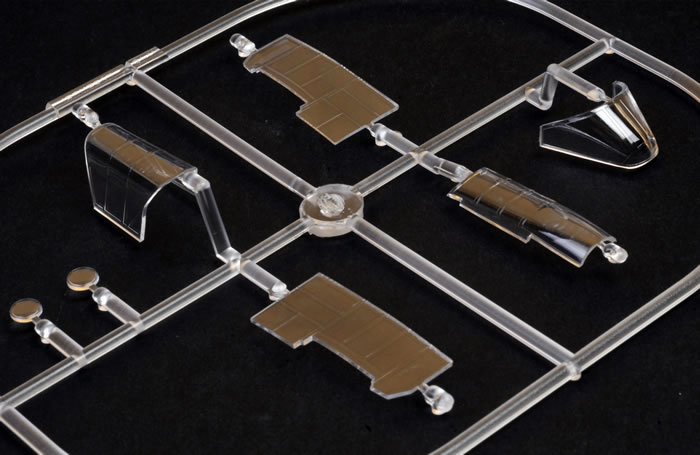
The wings are supplied as upper and lower left and right halves. The fabric surfaces are represented by subtle scalloping and raised stringers. This is moulded onto the fuselage, wings and the elevators.
On the original Gavia kit, there was a problem with the fit of the wing struts but Eduard has relocated the locating holes on the underside of the wings to correct this issue.
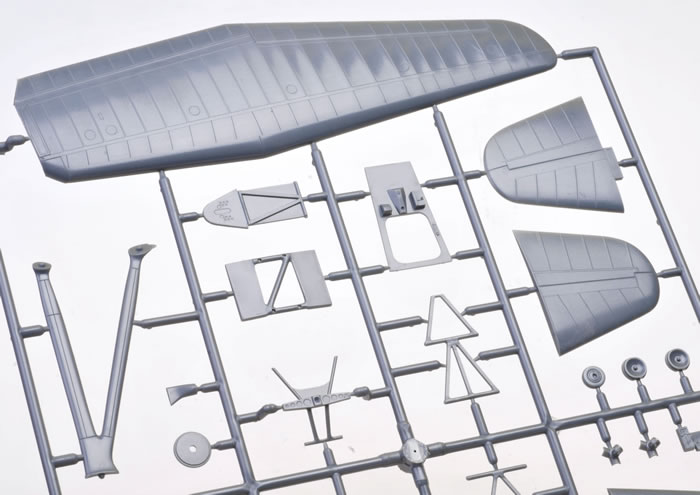
Eduard also offers the option of external centreline tank / stowage plus the fixed ladder used by 161 (SD) Squadron.
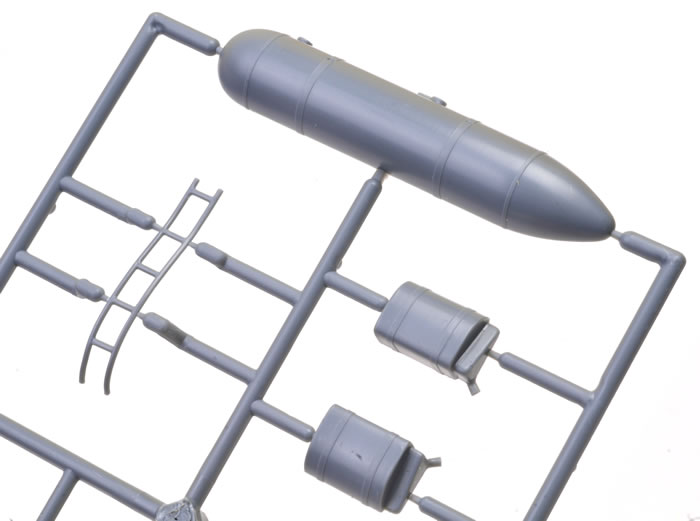
Canopy masks are included, which are even more welcome than usual with the relatively complex glasshouse frame arrangement of the Lysander canopy.
Markings
Markings are supplied for five Lysander Mk.IIIs:
-
Lysander Mk.III SCW, V9287, No. 161 (SD) Squadron RAF, air base Tempsford, 1942
-
Lysander Mk.III SCW, V9367, No. 161 (SD) Squadron RAF, air base Tempsford, 1944
-
Lysander Mk.IIIA, V9374, No. 613 Squadron RAF, Britain, 1941
-
Lysander Mk.IIIA, V9437, No. 309 Squadron RAF, air eld Dunino, Skotsko, 1942
-
Lysander Mk.III, T1429, No. 26 Squadron RAF, air base Gatwick, 1940/41
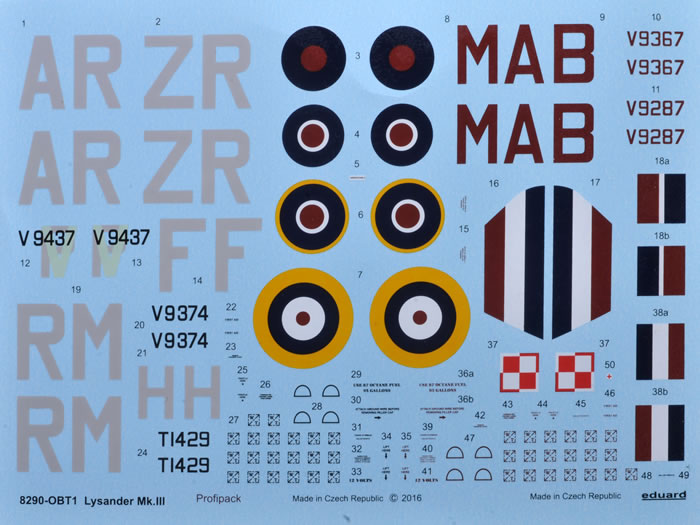
The decals have been produced by Eduard. Printing, colours and registration is perfect on my sample.
Eduard's 1/48 scale Lysander dates from 2001 and therefore represents a different generation of tooling and detail compared to recent releases.
Even so, Eduard's 1/48 scale Lysander is still the best kit of the type and stands up to scrutiny very well today, especially with the inclusion of photo-etched detail parts, plus masks to deal with that pesky glasshouse canopy!
Definitely Still Recommended.
* Historical summary courtesy of Wikipedia.
Thanks to Eduard for the sample
Review Text Copyright © 2016 by
Brett Green
Page Created 22 August, 2016
Last updated
23 August, 2016
Back to HyperScale Main Page
Back to Reviews Page |
